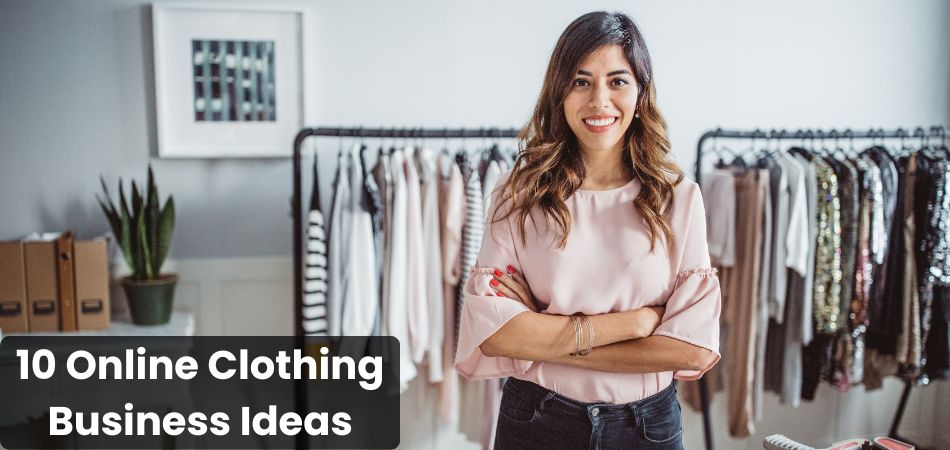Online clothing businesses are more exciting and accessible than ever before. With the fashion industry constantly developing, 2025 brings fresh opportunities for creative entrepreneurs to carve out their niche.
From sustainable fashion to customized apparel, the possibilities are endless for those ready to tap into this dynamic market. If you’re looking for inspiration, these 10 online clothing business ideas to start in 2025 can inspire your next big business.
Some of the online clothing business ideas are clothing rental, fashion boutique, sustainable fashion, custom clothing, athleisure wear, custom printing, dropshipping, handmade clothing, online consignment, and vintage clothing.
Throughout this post, we explore some online clothing business ideas to start in 2025 that align with current trends and consumer preferences. Get ready to discover innovative concepts and actionable insights to launch a business that stands out and succeeds in the year ahead.
10 Online Clothing Business Ideas to Start in 2025
An online clothing business in 2025 offers endless opportunities for creativity and profitability. Sustainability, personalization, and convenience are top priorities in the fashion industry. Whether you’re passionate about trends or niche markets, these ideas can help you build a successful business in the year ahead.

1. Clothing Rental
The clothing rental market is booming as consumers prioritize affordability and sustainability. Launch an online rental service specializing in formal wear, maternity clothes, or even designer pieces. Offer flexible subscription plans or one-time rentals to cater to diverse customer needs. With proper inventory management, you can create a business that’s both scalable and eco-friendly.
2. Fashion Boutique
An online fashion boutique allows you to showcase your unique style and curate trendy collections. Focus on a specific audience, like plus-size fashion, maternity wear, or streetwear, to stand out. Create a visually appealing website and use social media to connect with your target audience. Consistent branding and exceptional customer service are key to building a loyal customer base.
3. Sustainable Fashion
Consumers are increasingly drawn to eco-friendly and ethical clothing options. Start a sustainable fashion brand offering items made from organic, recycled, or biodegradable materials. Highlight your ethical sourcing and production processes to attract conscious shoppers. Partner with influencers to spread awareness and drive sales for your green business.
4. Custom Clothing
Personalization is a major trend, making custom clothing a lucrative niche. Offer customized outfits or made-to-order pieces based on customer measurements and preferences. Utilize online design tools to let users create their own designs. This unique approach enhances customer satisfaction and ensures repeat business.
5. Athleisure Wear Brand
Athleisure wear remains a popular choice for style and comfort. Create a brand offering high-quality, versatile pieces that transition from workouts to casual outings. Focus on breathable fabrics, modern designs, and inclusive sizing to appeal to a broad audience. Market your brand through fitness influencers and active lifestyle communities.
6. Custom Printing
Custom printing businesses cater to individuals and organizations looking for personalized apparel. Offer customizable t-shirts, hoodies, and other items for events, teams, or branding purposes. Use print-on-demand services to minimize upfront costs and inventory risks. Promote your service to small businesses, schools, and social groups for consistent orders.
7. Dropshipping
A dropshipping model eliminates the need for upfront inventory and storage. Partner with suppliers to offer trendy clothing items directly to customers through your website. Focus on marketing and customer experience while letting suppliers handle shipping and fulfillment. This low-risk business model is ideal for beginners entering the online fashion space.
8. Handmade Clothing
Handmade clothing appeals to shoppers seeking unique, artisan-quality pieces. Sell your creations, such as crocheted tops, embroidered dresses, or hand-dyed fabrics, on your website or marketplaces like Etsy. Highlight the craftsmanship and story behind each piece to add value. Build a loyal customer base by emphasizing exclusivity and creativity.
9. Online Consignment
Online consignment stores are perfect for eco-conscious and budget-friendly shoppers. Create a platform where individuals can sell their gently used clothing, with you earning a percentage of each sale. Offer a seamless user experience for both buyers and sellers to grow your audience. Promote your store as a sustainable alternative to fast fashion.
10. Vintage Clothing
Vintage clothing is timeless and always in demand. Source and sell curated collections of retro, 80s, or 90s fashion pieces. Build a strong brand identity that reflects the nostalgia and uniqueness of vintage styles. Use social media and storytelling to attract customers who value rare and stylish finds.
What Makes an Online Fashion Boutique Stand Out?
Customers are captivated, inspired, and engaged by an online fashion boutique. Beyond the usual considerations of target audiences and distinctive collections, several elements can set your boutique apart in a crowded marketplace. Here are some essential factors that ensure your boutique captures attention and earns loyalty.

Visual Storytelling That Resonates
Your boutique’s visuals should go beyond showcasing products to telling a cohesive story. Use high-quality photography, styled shoots, and videos that evoke emotions and align with your brand’s vibe. Consistent aesthetics across your website and social media create a memorable impression.
Exclusive Membership Perks
Offer membership options with perks like early access to new arrivals, exclusive discounts, or members-only sales. A VIP experience can advertise loyalty and make customers feel valued. This strategy encourages repeat purchases and builds a strong community around your brand.
Easy Mobile Shopping Experience
Ensure your boutique’s website is optimized for mobile shopping, as most users browse on their phones. Intuitive navigation, fast loading times, and secure checkout options are crucial for conversion. A mobile-friendly experience keeps your boutique accessible and professional.
Thoughtful Packaging and Delivery
Your packaging should reflect the premium experience of shopping at your boutique. Invest in eco-friendly, elegant packaging and include personal touches like thank-you notes. Reliable and prompt delivery completes the positive customer journey, leaving a lasting impression.
Dynamic Content for Continuous Engagement
Regularly update your boutique with fresh content, such as lookbooks, trend guides, and styling tips. Engaging content not only adds value but also positions your boutique as a trusted source of fashion inspiration. Stay interactive with newsletters, blogs, and live sessions to keep your audience connected.
Things to Consider When Starting an Online Clothing Business
Launching an online clothing business requires more than just a passion for fashion. Success depends on careful planning, strategic decisions, and a deep understanding of the digital marketplace. Here are some crucial factors to consider that will set you up for long-term success.
Getting to Know Legal and Tax Requirements
Register your business and ensure compliance with local and international laws. Research tax obligations, especially for online sales and cross-border transactions. Proper documentation protects your business and builds trust with customers.
Choose the Right E-commerce Platform
Select a platform that aligns with your business needs, offering user-friendly interfaces and scalability. Look for features like payment integration, inventory management, and customer analytics. A reliable platform ensures smooth operations and enhances customer satisfaction.
Define a Clear Pricing Strategy
Analyze competitors to set competitive yet profitable prices for your clothing line. Factor in costs like materials, shipping, marketing, and platform fees. Transparent pricing builds trust and helps attract your target audience.
Build a Reliable Supplier Network
Partner with trustworthy suppliers to maintain consistent product quality and availability. Diversify your sources to avoid dependency on a single supplier. Regular communication ensures timely delivery and smooth collaboration.
Create an Efficient Returns and Refund Policy
A clear, customer-friendly return policy boosts shopper confidence and minimizes disputes. Define processes for handling exchanges, refunds, and defective products. Communicate this policy effectively on your website to reduce confusion.
Monitor Key Performance Metrics
Track essential metrics like sales, website traffic, and customer retention rates. Use analytics tools to understand trends and optimize your strategies. Regularly reviewing these metrics helps identify opportunities for growth.
Prioritizing Customer Support
Establish multiple channels for customers to reach out, such as email, chat, or social media. Quick and helpful responses build trust and encourage repeat purchases. Train your team to handle complaints professionally and provide solutions promptly.
How to Make Profit in Clothing Business?
Profitability in the clothing business requires a blend of strategic planning, creativity, and smart decision-making. By focusing on key areas like operational efficiency and customer value, you can boost your margins while staying competitive. Here are six actionable tips to help you maximize profits in your clothing business.

- Focus on High-Margin Products: Identify and promote products with higher profit margins, such as exclusive or premium items. Highlight their unique features to justify pricing and encourage customers to invest.
- Upsell and Cross-Sell Strategically: Bundle complementary items or recommend related products to increase the average order value. Use discounts or offers to make these options more attractive to customers.
- Use Seasonal Trends and Limited Editions: Introduce seasonal collections or limited-edition designs to create urgency and drive sales. These time-sensitive items often command higher prices due to their exclusivity.
- Optimize Your Supply Chain: Negotiate better deals with suppliers and streamline logistics to reduce costs. Efficient supply chain management ensures timely delivery and minimizes waste.
- Invest in Digital Marketing Campaigns: Use targeted ads and social media campaigns to reach the right audience efficiently. Well-planned marketing efforts bring in consistent traffic, leading to higher sales.
- Build Long-Term Customer Relationships: Offer loyalty programs or special perks for repeat customers to encourage retention. Loyal customers not only generate steady revenue but also help with word-of-mouth promotion.
FAQs About Starting an Online Clothing Business
The process of starting an online clothing business can seem overwhelming, especially with so many factors to consider. Entrepreneurs often have recurring questions about the initial steps, operational challenges, and long-term growth strategies. Here are some frequently asked questions with clear and concise answers to guide you.
1. How Much Money Do I Need to Start an Online Clothing Business?
The startup cost depends on the scale and model of your business. A dropshipping setup may cost as little as a few hundred dollars, while creating your own brand could require thousands for production, marketing, and website development. Start small, scale wisely, and track expenses to stay within your budget.
2. How Do I Choose the Right Products for My Online Store?
Research market trends and analyze consumer behavior to identify in-demand products. Consider your personal expertise or interests to create a niche that differentiates your store. Offering unique, high-quality items that solve a specific need will increase your chances of success.
3. How Can I Attract Customers to My Website?
Use a combination of digital marketing strategies like SEO, social media ads, and influencer partnerships. Create engaging content such as blog posts, lookbooks, or styling videos to connect with your audience. Building trust through reviews and testimonials will also encourage new customers to shop.
4. What Challenges Will I Face When Starting an Online Clothing Business?
Common challenges include finding reliable suppliers, managing inventory, and competing in a saturated market. You may also face difficulties in maintaining consistent cash flow during the initial stages. Patience, adaptability, and data-driven decision-making can help overcome these obstacles.
5. How Do I Ensure the Quality of My Products?
Conduct thorough research when choosing suppliers and manufacturers, prioritizing those with positive reviews and certifications. Request samples to assess fabric, stitching, and overall quality before adding products to your store. Regular quality checks and customer feedback will help maintain high standards over time.
Final Words
Starting an online clothing business in 2025 presents exciting opportunities to turn creativity into profit. By focusing on trends, customer needs, and strategic planning, you can carve out a unique space in the competitive fashion industry.
From sustainable fashion to dropshipping, there are endless paths to explore. Our guide on 10 online clothing business ideas to start in 2025 highlights diverse opportunities that cater to various interests and expertise levels.
Whether you’re looking to launch your first venture or expand an existing one, the right approach can lead to success. Now is the perfect time to bring your vision to life!
